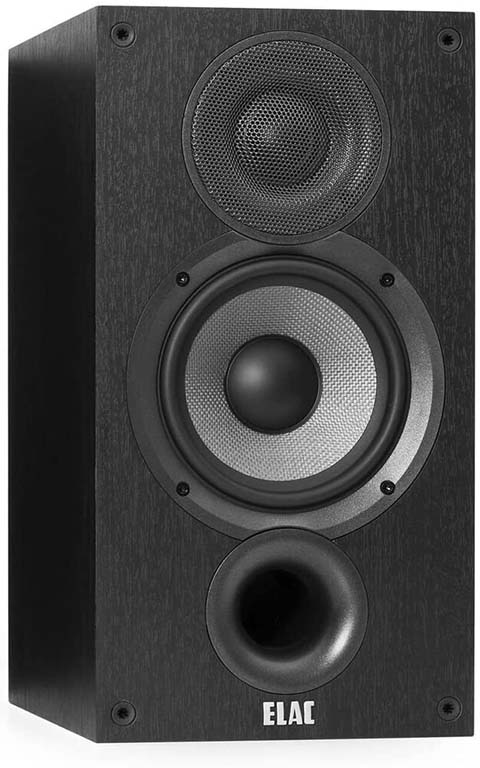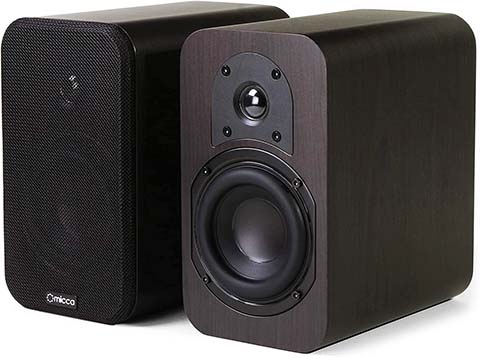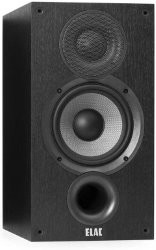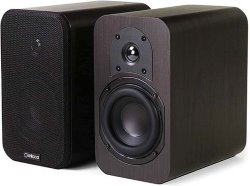ELAC Debut 2.0 B5.2 vs. Micca RB42

| ELAC Debut 2.0 B5.2 Bookshelf Speakers | Micca RB42 Reference Bookshelf Speakers |
| MSRP | |
| $330 | $150 |
| Dimensions (H × W × D) | |
|
13.43” × 7.09” × 9.21” 341mm × 180mm × 234mm |
8.70” × 4.90” × 7.90” 221mm × 124mm × 201mm |
| Power Type | |
| Passive | Passive |
| Frequency Response | |
| 46-35,000 Hz | 50-20,000 Hz |
| ASR Score | |
| n/a | 4.4 |
| ASR Score w/Subwoofer | |
| n/a | 6.6 |
|
Amazon.com
|
Amazon.com
|
Key Takeaways
TLDR Summary: In the realm of affordable yet high-fidelity bookshelf speakers, the ELAC Debut 2.0 B5.2 and Micca RB42 stand out. The ELACs, designed by the renowned Andrew Jones, deliver a wide soundstage with clear highs and coherent mids, albeit requiring a bit more power to shine. The compact Micca RB42s counter with a rich, robust bass response that belies their size, thanks to a ported enclosure design. Both offer exceptional value, but the ELACs may edge out for critical listening, while the Miccas impress in smaller spaces or as part of a home theater setup. Choosing between them would depend on listener preference and specific use cases.
Speaker Comparison
When we look at the bustling world of bookshelf speakers, it's impossible to ignore the presence of the ELAC Debut 2.0 B5.2 and the Micca RB42 Reference Bookshelf Speakers. Both have made splashes in the audiophile community, championed for their remarkable performance relative to their modest price points. But, as any discerning listener would ask, how do they stack up against each other in a head-to-head comparison? It's a classic battle, reminiscent of David and Goliath, with ELAC's well-established reputation pitted against the up-and-coming challenger, Micca.
Design and Build Quality
The ELAC Debut 2.0 B5.2 speakers boast a clean, modern aesthetic that is as understated as it is functional. Their black ash vinyl finish is simple yet elegant, ensuring that they can blend into any room decor. In contrast, the Micca RB42 speakers have a more compact and slightly more exotic appeal, with a rich, wood grain vinyl finish that exudes a warm, classic vibe. Both sets of speakers feel solid and well-constructed, but the ELAC has a slight edge in build quality, which is reflected in its slightly higher price point.

 (at Amazon.com)
(at Amazon.com)Sound Performance
Sound quality is where the rubber meets the road, and the ELAC B5.2 demonstrates an impeccable balance across the sonic spectrum. With a newly-designed 5.25-inch Aramid-Fiber woofer and a 1-inch cloth dome tweeter, these speakers deliver a soundstage that is expansive and detailed. The bass response is tight and punchy without overpowering the mids and highs. The Micca RB42, on the other hand, while smaller in stature with a 4-inch woofer, surprises with its robust, rich bass that belies its size. The silk dome tweeter of the RB42 complements the lower frequencies with clear and smooth highs, though it may lack some of the airiness that the ELAC B5.2 exhibits.
Stereo imaging and separation are critical for a true audiophile experience, and this is where the ELAC B5.2 shines. The speakers create a three-dimensional soundstage that allows each instrument to occupy its own space, making for an engaging listening experience. The Micca RB42s, while still impressive in their right, deliver a slightly more intimate soundstage, which can be a double-edged sword: it's ideal for near-field listening but might not fill a room as effortlessly as the B5.2s do.

 (at Amazon.com)
(at Amazon.com)Compatibility and Versatility
Power handling is an important factor to consider, especially for those planning to pair their speakers with a variety of amplifiers. The ELAC B5.2 handles a respectable 120 watts, making it compatible with a wide range of home theater receivers and stereo amplifiers. The Micca RB42s, with a maximum power handling of 100 watts, aren't far behind, but they typically require a bit more power to truly sing, which means you'll need to be slightly more considerate when matching them with an amplifier.
Compare to similar speakers
In terms of versatility, both the ELAC Debut 2.0 B5.2 and Micca RB42 speakers are relatively easy to place in a room, thanks to their front-firing ports. However, the ELAC B5.2 is a bit more forgiving in placement due to its slightly larger cabinet, which helps distribute sound more easily across a variety of listening environments. The Micca RB42s are compact and can fit in tighter spaces, but they benefit from careful positioning to optimize their sound performance.
Value Proposition
Finally, when considering value, it's important to account for the longevity and adaptability of the speakers. The ELAC Debut 2.0 B5.2 stands as a formidable investment in the long run, with its enduring build quality and timeless sound performance. The Micca RB42, while an incredible value for its price, may cater more to the entry-level or budget-conscious audiophile who doesn't want to compromise on sound but has space constraints or prefers a smaller footprint.
In conclusion, choosing between the ELAC Debut 2.0 B5.2 and the Micca RB42 Reference Bookshelf Speakers depends on one's personal preferences, listening environment, and budget. The ELAC offers a more refined and expansive sound with slightly better build quality, while the Micca brings a powerful punch in a compact package, being especially suited for smaller rooms or desktop setups. Both are excellent choices in their own right, and either will reward listeners with a delightful sonic experience that belies their modest cost. The ultimate decision rests in the ears—and the room—of the beholder.
- ELAC Debut 2.0 B5.2 reviews and FAQs
- Micca RB42 reviews and FAQs
Check Current Prices: |
|
|
Amazon.com
|
Amazon.com
|
Affiliate Disclosure: As an Amazon Associate, we earn from qualifying purchases.

